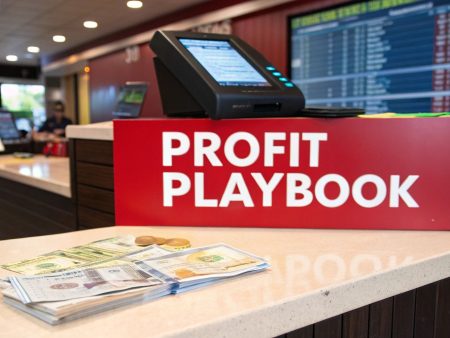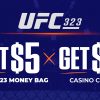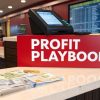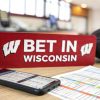Ever seen a race where one runner gets a head start just to make things interesting? That's the point spread in a nutshell. It’s a clever way to level the playing field between two teams that aren't evenly matched, turning just about any game into a nail-biter for bettors.
What a Point Spread Actually Means

Log into any top offshore sportsbook like Bovada or MyBookie, and you'll quickly see that most matchups are lopsided. One team is almost always the clear favorite, at least on paper. If betting were just about picking the winner, everyone would pile onto the stronger team, which would be pretty boring—and unprofitable for the books.
The point spread is the solution. Think of it as a handicap that sportsbooks like BetUS, Sportsbetting.ag, and BetAnything assign to the favorite. This simple tweak makes betting on either team a viable, and often difficult, choice. It’s the lifeblood of sports betting, and understanding the ins and outs of an NFL betting line can give you a serious leg up.
Favorite vs Underdog
Every point spread comes down to two roles: the favorite and the underdog. The favorite is the team expected to win, and you'll spot them by the minus sign (-) next to their name. The underdog is the team expected to lose, marked with a plus sign (+).
But here's the twist: for your bet to win, it's not about who wins, but by how much.
- The Favorite (-): To "cover the spread," they have to win the game by more points than the spread number.
- The Underdog (+): They can either win the game outright or lose by fewer points than the spread.
It’s a simple concept, but it changes everything. The favorite can win the game, but if they don't do it decisively enough, they fail to cover. When that happens, underdog bettors are the ones cashing tickets at sites like Xbet and Bovada.
To make this crystal clear, let's break down a typical point spread bet.
Breaking Down a Point Spread Bet
This table shows you exactly what each part of the spread means for your wallet when you bet at sportsbooks like MyBookie or BetUS.
| Team | Point Spread | What This Means to Win Your Bet | Odds |
|---|---|---|---|
| New York Giants | +7.5 | The Giants must win the game outright or lose by 7 points or less. A 7-point loss is a win for you. | -110 |
| Dallas Cowboys | -7.5 | The Cowboys must win the game by 8 points or more. A 7-point win is not enough. | -110 |
This example lays it all out. A bet on the Cowboys isn't just a bet on them winning; it's a bet on them winning big.
What Is the Juice or Vig?
When you check out a point spread on a site like Xbet or BetAnything, you'll notice another number right next to it, which is almost always -110. This is the "juice" or "vigorish" (vig), and it's basically the sportsbook's fee for taking your action.
Think of the juice as the house's cut. That -110 means you have to risk $110 just to win $100. It's the small commission that guarantees the sportsbook makes a profit no matter which side wins.
This built-in commission is why the house always has an edge at all offshore sites, from Sportsbetting.ag to Bovada. To be profitable over the long haul, you have to win more than 50% of your bets to overcome the vig. It's a numbers game, and the juice is a key part of the equation.
How to Confidently Read Betting Lines
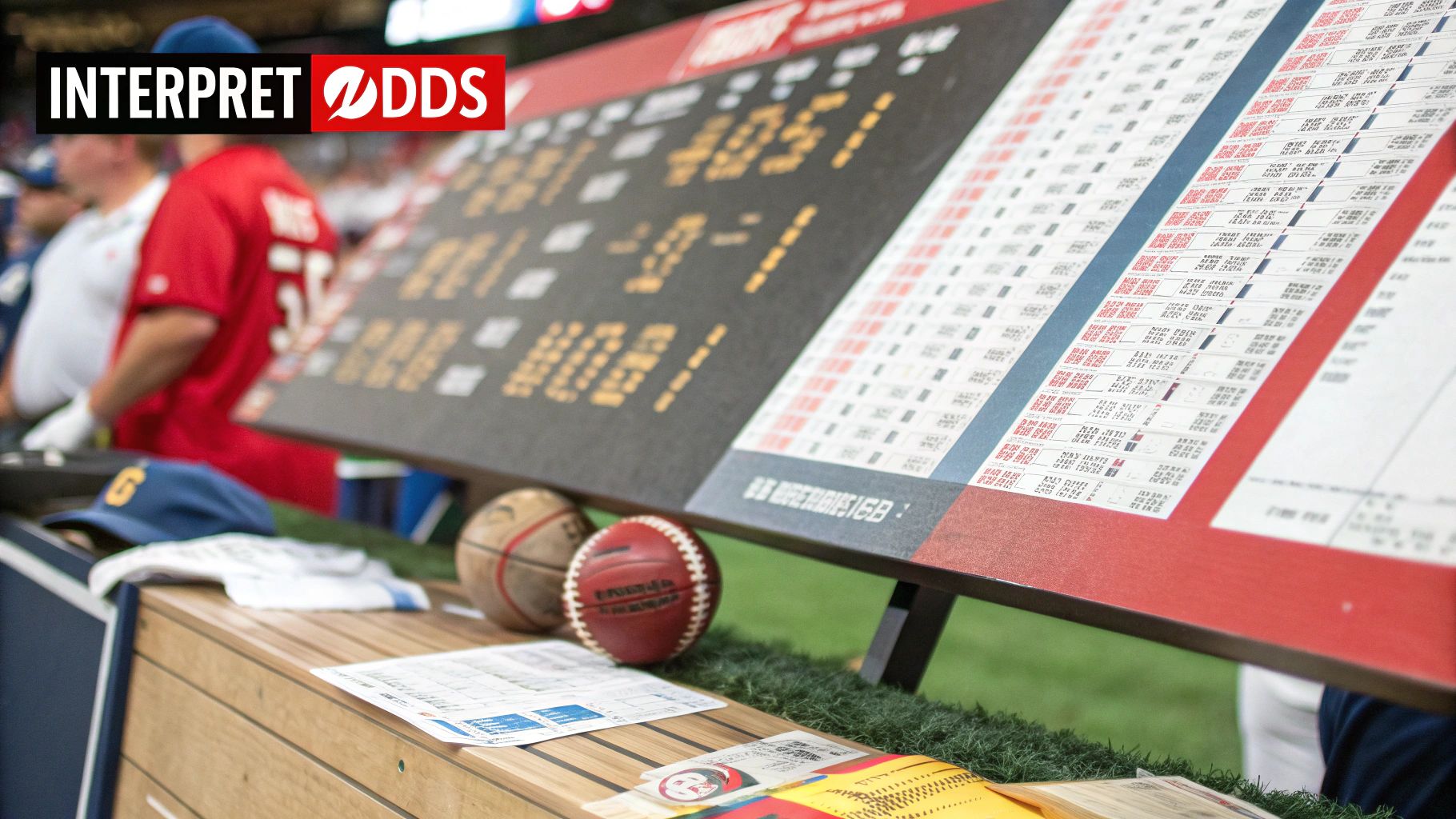
Alright, you've got the basics of what a point spread is. Now it’s time to stare down a real betting line and see what it's all about. When you first log into an offshore site like BetUS, Sportsbetting.ag, or MyBookie, the screen can look like a mess of numbers. But don't worry, every single digit has a job to do.
Let's break down a classic NFL rivalry to make sense of it all:
Green Bay Packers -6.5 (-110) vs. Chicago Bears +6.5 (-110)
That one little line of text tells you absolutely everything you need to place a smart bet. Once you can dissect this, you can confidently analyze any game on the board at sportsbooks such as Bovada, Xbet, or BetAnything.
Decoding the Spread and the Favorite
The first thing your eyes should catch is the minus sign (-) next to the Green Bay Packers. That’s your dead giveaway—they’re the favorite. The Chicago Bears, with their plus sign (+), are the underdog. Simple enough.
That number right next to the sign, 6.5, is the point spread itself. This is the handicap the sportsbook has set for the game.
- To win a bet on the Packers (-6.5): They have to win the game by 7 points or more. If they win by 6, your ticket is a loser.
- To win a bet on the Bears (+6.5): They can either win the game outright, or just lose by 6 points or less.
This is the heart of spread betting. It's not just about who wins, but by how much. When your pick beats that handicap, it’s called covering the spread.
The Magic of the Half-Point
You'll notice that spreads often end in a half-point (.5), just like our -6.5 example. This isn't random. Sportsbooks like MyBookie, Bovada, and BetAnything do this on purpose to guarantee a winner and a loser on every single bet.
The half-point eliminates the possibility of a "push," which is just another word for a tie. If the spread was an even -6 and the Packers won by exactly six points, every bet would be refunded. That .5 ensures there's always a decisive outcome.
This tiny detail removes any confusion and makes sure that for every winning bet, there's a losing one. That’s how the house collects its commission at every sportsbook, including BetUS and Xbet.
Understanding the Odds (-110)
Last but not least, you have the number sitting in the parentheses: (-110). This is the price of the bet, often called the odds, juice, or vig. It tells you exactly how much you need to risk to win a certain amount.
The industry standard for point spread bets is -110. This means you must wager $110 to win $100 in profit (getting back $210 total). This price typically applies to both sides of the bet—the favorite and the underdog. It's the small fee you pay to play, and it’s how sportsbooks from Xbet to BetAnything guarantee they stay in business.
Why Sportsbooks Change the Point Spread
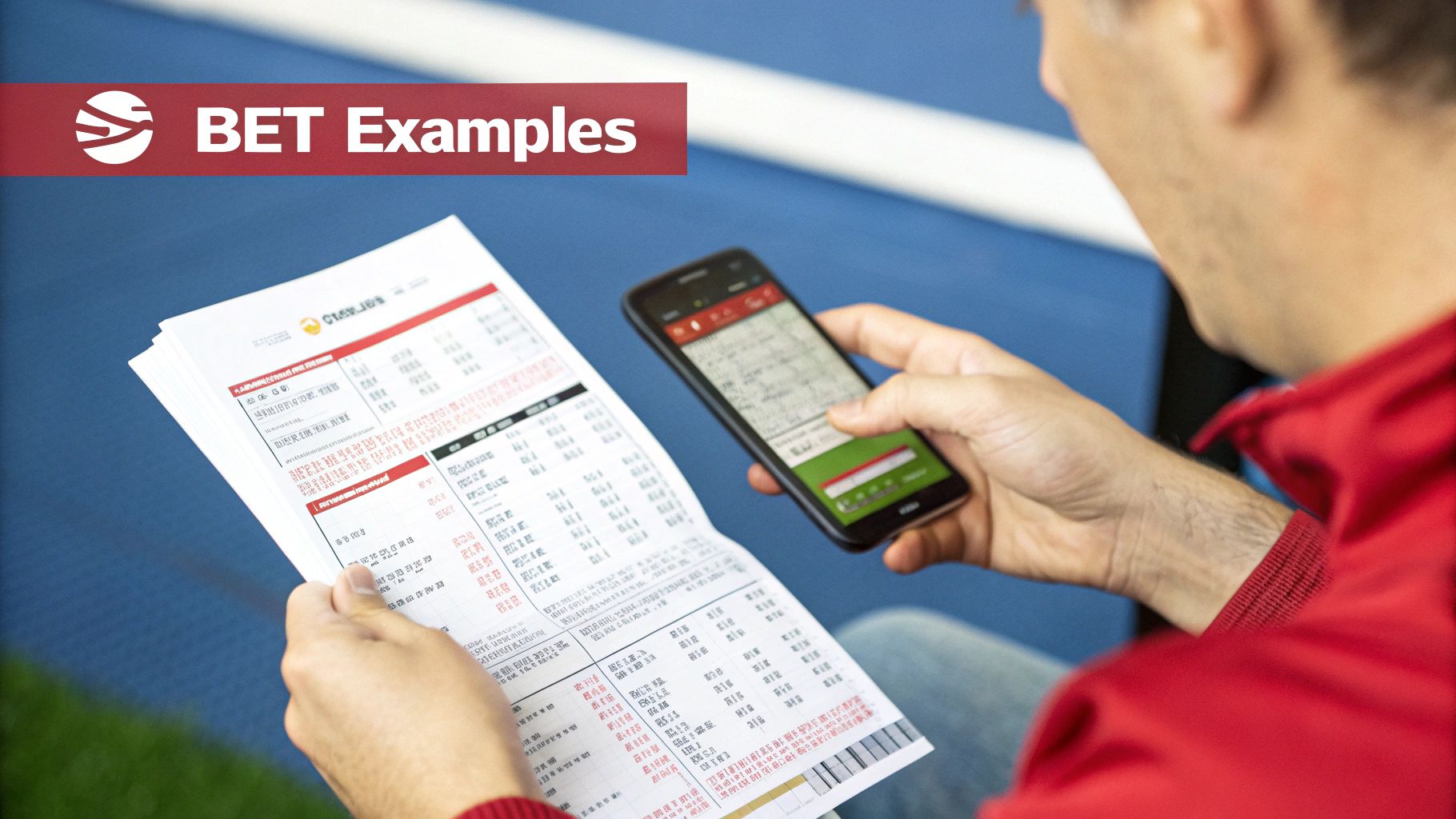
Ever look at a point spread on Monday morning and see it completely different by kickoff on Sunday? You might see a team open as a -4 favorite, only to find them sitting at -5.5 just before the game starts. This isn't random. It’s the sportsbook actively managing its money and risk.
A huge misconception is that the point spread is just the sportsbook’s prediction of the final score. It’s not.
Think of the spread as a balancing act. The book’s main goal is to get roughly the same amount of money bet on both sides of a game—the favorite and the underdog. When offshore sites like MyBookie, BetUS, and Bovada nail this balance, they make a guaranteed profit from the juice, no matter which team actually covers.
So, when you see that line move, it’s a direct response to something forcing the book to rebalance the scales.
The Impact of Betting Volume
The single biggest reason a line moves is simple: money talks.
If 90% of the early bets pour in on the favorite, a sportsbook like Sportsbetting.ag or Xbet is suddenly in a very lopsided, and very dangerous, position. They are now essentially massive fans of the underdog, praying they cover the spread. That’s not a business model they like.
To fix this, they’ll shift the line to make betting on the favorite a little less appealing. That -6.5 spread might jump to -7.5. This move encourages new bettors to look at the underdog, who now gets an extra point of value. It's all about attracting money to the other side.
Sharp Money vs. Public Money
In the world of sports betting, not all money is created equal. Sportsbooks are constantly watching the divide between two very different types of bettors.
- Public Money: This is the cash from everyday, casual fans. They usually bet smaller amounts and are drawn to the big-name teams, star players, and almost always, the favorites.
- Sharp Money: This comes from a small but powerful group of professional bettors. Sharps wager huge sums based on sophisticated models and deep analysis. When they bet, the books listen.
A single massive bet from a sharp can move a line more than thousands of small bets from the public. Sportsbooks like Bovada, Xbet, and BetAnything have immense respect for sharp action because these pros have a proven track record of winning. If a group of sharps all hit one side of a game, the book will adjust the line almost instantly, assuming the pros know something the rest of us don't.
This is where you can find some of the most interesting market dynamics. You might see a team getting a whopping 91% of the total money wagered but only 37% of the total number of bets. That’s a giant red flag that a few huge, informed wagers from sharps are fading the popular opinion.
Other Key Factors
While betting patterns are the main driver, other real-world events can force sportsbooks like Sportsbetting.ag, BetAnything, and MyBookie to shift a line before a single dollar is even placed. These are things that fundamentally change how a game is likely to play out.
Here are a few of the big ones:
- Player Injuries: A star quarterback getting ruled out can swing a line by several points in a matter of seconds. Even an injury to a key lineman can have a real impact.
- Weather Conditions: Is there 30 mph wind in the forecast? Heavy snow or a downpour? Bad weather often suppresses scoring and favors teams with strong running games, forcing oddsmakers to adjust the spread and the total.
- Team News: Anything from an unexpected lineup change to a key player getting suspended can affect a team's chances and, as a result, the spread.
Once you understand these forces, you stop just betting on teams and start betting on numbers. That’s a crucial step toward becoming a much smarter bettor.
Point Spread Betting in Action
Theory is one thing, but seeing a point spread play out in real-time is where it all starts to click. To really get a handle on the idea of "covering the spread," let's walk through a couple of classic scenarios you’d find on any given gameday at sportsbooks like Xbet, BetAnything, or Bovada.
NFL Spread Example
Picture this: It's Sunday afternoon, and you're eyeing a classic AFC West showdown.
- Kansas City Chiefs -6.5
- Las Vegas Raiders +6.5
The Chiefs are the favorites here, which means they don't just have to win—they have to win by 7 points or more to make their bettors happy. The Raiders, on the other hand, are the underdogs. They can either pull off an upset and win the game outright, or they can simply lose by 6 points or less.
Let's look at how this could play out:
- Final Score: Chiefs 30, Raiders 20: The Chiefs won by a solid 10 points. Since 10 is way more than 6.5, Chiefs bettors win.
- Final Score: Chiefs 24, Raiders 21: The Chiefs got the "W," but only by 3 points. Since 3 is less than the 6.5 they needed to cover, Raiders bettors win.
- Final Score: Raiders 27, Chiefs 24: The Raiders didn't just cover the spread; they won the whole game. An easy victory for Raiders bettors.
Notice how in two of these three outcomes, the bet on the underdog was the winning ticket. That’s the magic of the point spread—it creates a real contest on both sides of the bet, even when one team is heavily favored to win.
NBA Spread Example
Now, let's swap the gridiron for the hardwood with a high-profile NBA matchup from MyBookie or Sportsbetting.ag:
- Boston Celtics -4.5
- Los Angeles Lakers +4.5
Here, the Celtics are favored and need to win by 5 or more points. The Lakers just have to keep it close—win the game or lose by 4 points or less.
Let's check the box score:
- Lakers lose by 2 (e.g., Celtics 110, Lakers 108): The Lakers hung tough but came up just short. Since a 2-point loss is well within the +4.5 spread, Lakers bettors win.
- Lakers lose by 5 (e.g., Celtics 110, Lakers 105): A 5-point loss is just enough to cross that 4.5-point threshold. The Celtics covered, so Celtics bettors win.
These examples show that the principle is exactly the same in a faster-paced game like basketball. At the end of the day, the final margin is the only thing that matters.
This simple infographic breaks down the process from doing your homework to placing your wager.

As you can see, smart betting isn't just about luck. It’s a logical progression from research to action.
It's pretty incredible how good oddsmakers at places like MyBookie, BetUS, and BetAnything are at setting these lines. In the NFL, the point spread has a surprisingly strong correlation with how games actually turn out, especially with bigger numbers. An analysis of over 4,800 NFL games found that when the point spread is 10 points or more, the favorite wins the game more than 80% of the time.
It's a great reminder that while underdogs can and do cover, a big spread often signals a truly dominant team.
Smarter Ways to Bet the Spread
Knowing what a point spread is gets your foot in the door. But actually betting it smart? That’s a whole different ballgame. Making the leap from a casual fan to a sharp bettor means you stop just picking teams you like and start hunting for real value in the numbers.
This isn’t about some magic formula for guaranteed winners—those don’t exist. It's about building a disciplined approach and using proven strategies that give you a fighting chance to find an edge against the sportsbooks.
Go Against the Grain
One of the oldest and most effective long-term strategies is known as “betting against the public,” or simply “fading the public.” The logic here is pretty straightforward: most casual bettors love to pile on popular teams, big-name favorites, or the squad that just had a monster game last week. This sends a tidal wave of money to one side of the bet.
Sportsbooks see this lopsided action and will often move the line to make that popular side a little less tempting. By betting against that public herd, you’re often siding with the sharper, more analytical bettors who are looking for an inflated number to exploit. Offshore books like Bovada, MyBookie, and BetAnything are notorious for seeing heavy public money on big national TV games, which creates some of the best opportunities to find value on the other side.
The Power of Line Shopping
Think about it this way: if you could buy the exact same TV at five different stores, but one of them had it for $50 cheaper, you'd go there every single time. That's exactly what line shopping is, and it's probably the single most important habit any serious bettor can develop.
Never place a bet without first checking the spread at multiple sportsbooks. That extra half-point you find can be the difference between a winning ticket and a frustrating loss.
Before you jump on the Patriots at -3, you need to see what the line is at places like BetUS, Sportsbetting.ag, and Xbet. It’s not uncommon to find one of them offering the same game at -2.5. That half-point might not seem like a big deal, but trust me, over a full season, those half-points add up and can make a massive difference to your bankroll.
Point Spread Line Shopping Example
Just to show you how much lines can vary from book to book for the exact same game, take a look at this real-world example.
| Sportsbook | Favorite Spread | Underdog Spread |
|---|---|---|
| MyBookie | Cowboys -7 (-110) | Eagles +7 (-110) |
| BetUS | Cowboys -6.5 (-115) | Eagles +6.5 (-105) |
| BetAnything | Cowboys -7.5 (+100) | Eagles +7.5 (-120) |
| Bovada | Cowboys -7 (-105) | Eagles +7 (-115) |
| Xbet | Cowboys -6.5 (-120) | Eagles +6.5 (+100) |
| Sportsbetting.ag | Cowboys -7 (-112) | Eagles +7 (-108) |
In this scenario, if you want to bet on the Cowboys, you have multiple options at -6.5, but BetUS gives you the best price. But if you're backing the Eagles, BetAnything is giving you a much better number at +7.5. This is why having accounts at multiple sportsbooks is non-negotiable for anyone serious about winning.
Respect Key Numbers and Home Field
In a game like football, not all numbers are created equal. Because of the way teams score—with touchdowns (7 points) and field goals (3 points)—certain final margins of victory pop up way more often than others. These are called key numbers, and the most important ones by far are 3 and 7.
This is why a sportsbook moving a line from -2.5 to -3.5 is a massive deal. If you bet the favorite at -2.5 at Bovada, you win your bet if they win by a field goal. But if you take them at -3.5 at Xbet, that same result is a losing ticket. You have to pay close attention to whether a spread is on, above, or below a key number.
Lastly, always remember that home-field advantage is already baked into the point spread from the start. Oddsmakers usually give the home team a built-in credit of about 2 to 3 points before they even set the opening line. So, if you see a road team listed as the favorite, that's a huge sign of respect—it means the sportsbook thinks they are significantly better than the home team.
The Math Every Point Spread Bettor Must Know
If you want to get serious about betting on point spreads, you have to look past the team matchups and get comfortable with some simple math. It’s a classic rookie mistake to think, "Hey, if I just win half my bets, I'll be fine." Unfortunately, it doesn't work that way. The sportsbook has a built-in advantage that you need to overcome first.
That advantage is called the juice, or vigorish. Think of it as a small commission the house takes for handling your bet. It’s why you almost always see the number -110 next to a point spread on sites like MyBookie, BetUS, or BetAnything. That isn't just a random number; it's the price of admission, and it’s the single biggest reason most bettors lose money.
Calculating Your Breakeven Point
So what does -110 actually mean for your wallet? At standard -110 odds, you’re risking $110 to win $100. This slight difference is where the sportsbook makes its money. If you bet $110 on two games and go 1-1, you’ve won $100 on one bet but lost $110 on the other. That leaves you down $10. A 50% win rate is a slow bleed.
So, what's the magic number you need to hit just to stay in the game? Let's run the numbers.
To figure out your breakeven point, you just divide the amount you risk by the total potential payout (your risk plus your potential winnings).
Breakeven Point = Risk / (Risk + Win)
$110 / ($110 + $100) = $110 / $210 = 0.5238
There it is. You have to win 52.38% of your point spread bets just to tread water. Anything less than that, and you're handing your money over to the book over the long haul.
This is probably the most important concept in all of sports betting. That built-in juice means you’re fighting an uphill battle from the start. To make any real profit after the commission, you have to be significantly better than average.
The Target for Long-Term Profit
Getting to a 52.4% win rate is tough enough, but nobody gets into this to just break even. You're here to build a bankroll and end the season with more money than you started with. To do that, you have to set your sights higher.
The gold standard for a professional, successful sports bettor is winning around 55% of their point spread bets. It might not sound like much of a jump from the breakeven point, but the difference between winning 52.4% and 55% of the time is enormous. A bettor who consistently hits that 55% mark at books like Sportsbetting.ag, Xbet, or Bovada isn't just good; they're in the elite tier.
Understanding this math gives you a dose of reality. It shows you just how thin the margins are and why things like disciplined bankroll management and shopping for the best lines are so critical. It’s not just about picking winners; it’s about winning often enough to beat the house edge.
Finding a reliable place to start your betting journey is key. At USASportsbookList, we review and compare the top online sportsbooks to help you make informed decisions and find the best lines. Explore our curated list of trusted sportsbooks and start betting smarter today.
Article created using Outrank
